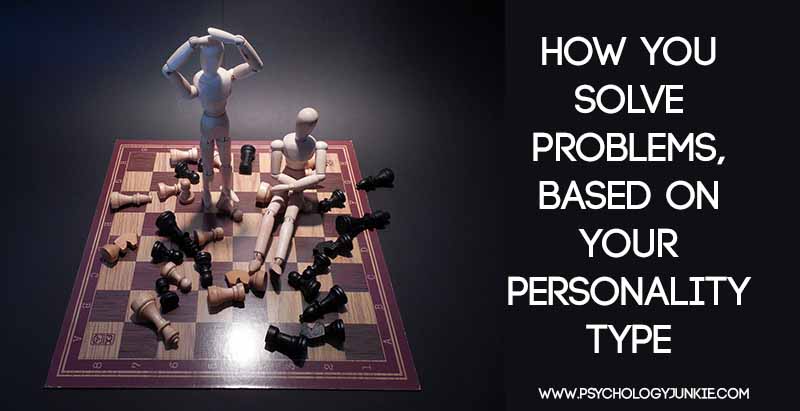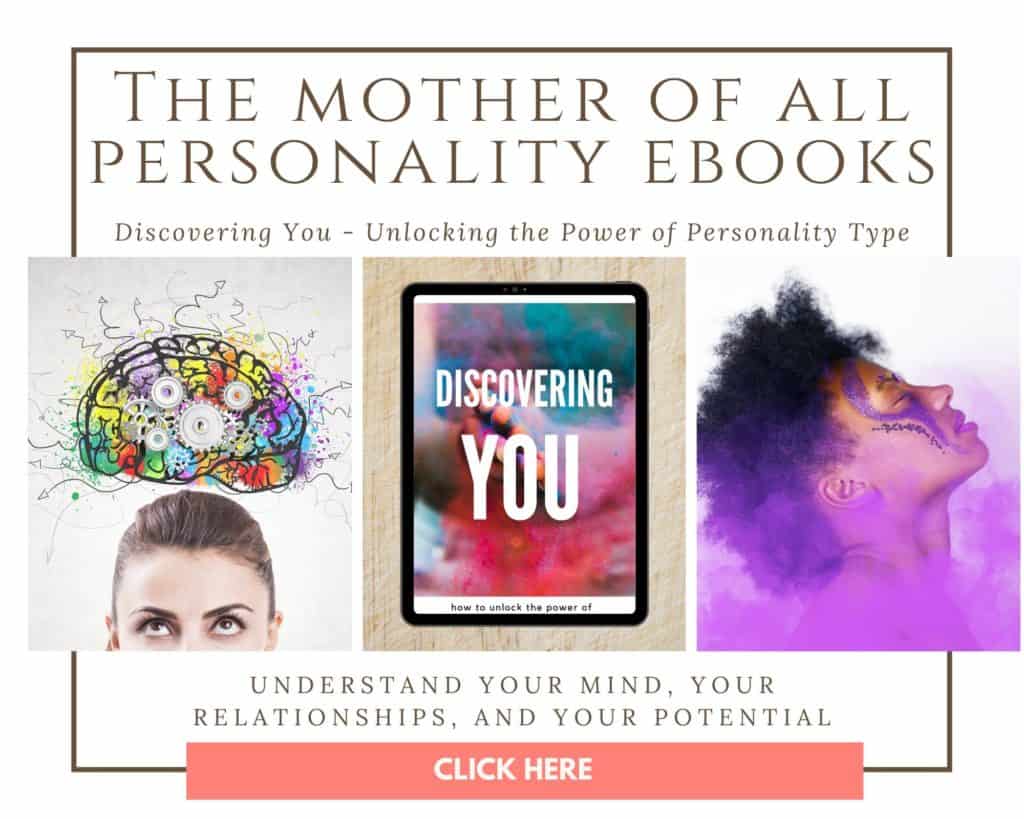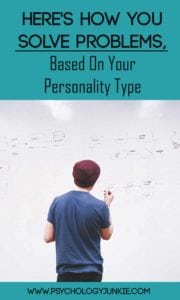Here’s How You Solve Problems, Based on Your Personality Type
One of the greatest gifts that a knowledge of personality type can give you is an ability to understand how different people solve problems. So many arguments and conflicts arise because people don’t solve problems the same way! We sometimes accidentally shut down other people’s solutions without seeing where they are coming from. What if we could understand how the other person in the equation thinks? What if we could see what’s important to them? This article is my small attempt at making that process easier.
Not sure what your personality type is? Take our new personality questionnaire here. Or you can take the official MBTI® here.

Here’s How You Solve Problems, Based on Your Personality Type
How ISTJs Solve Problems
ISTJs start the problem-solving process by looking at the history and factual background of the problem at hand. “What happened first?”, “What’s the timeline?”, “What does my experience tell me about this person or problem?”. They want to develop a sequential timeline of the problem to understand it. After they create a mental timeline, they look at the facts, procedures, and goals that everyone can agree upon. They try to figure out if they’ve ever encountered a problem like this before, and if so, whether they had any useful techniques that they could use again. They look at the resources needed to solve the problem. They ask themselves “What is the most logical known path that will bring resolution?”.
Potential Blind Spots: They might forget to consider the human element of the problem and might choose a path that doesn’t take into consideration the personal needs of others. They also might get stuck looking at only one tried-and-true solution when there are several better solutions. They can also get so stuck looking at the facts of the problem that they fail to look at the deeper underlying meaning of why it happened.
Most likely to clash on decisions with ENFJ, INFJ, and ENFP personality types. At the same time, these types might offer input that covers the ISTJs blind spots.
Read This Next: 24 Signs That You’re an ISTJ Personality Type
How ISFJs Solve Problems
ISFJs, similarly to ISTJs, analyze the history of the problem or conflict first. They want to know what started the problem, what happened after the problem occurred, and then work to create a mental timeline. They also look at their past experience to see if they have any useful lessons they could apply to solve the problem. Afterward, they consider how the conflict situation might impact the people involved. They look at the human elements. “Who will be affected by this problem?”, “What are the personal impacts of this conflict?”, “How can we achieve a win-win situation?”.
Potential Blind Spots: ISFJs can get so focused on the human impacts of the problem that they sidestep the most logical, efficient resolution. They can also get stuck in a comfort zone where they consistently use methods they’ve learned in the past instead of entertaining new ideas or brainstorming alternate ways to solve the problem that might be better.
Most likely to clash on decisions with ENTJ, INTJ, and ENTP personality types. At the same time, these types might offer input that covers the ISFJs blind spots.
Read This Next: 24 Signs That You’re an ISFJ Personality Type
How ESTJs Solve Problems
ESTJs use causal analysis when they are trying to solve a problem. They want to understand the logical cause and effect of the problem and then sort out the known options for managing the conflict. They want to see the facts first. They will usually dismiss any irrelevant data or opinions that aren’t steeped in fact or logic. Personal opinions and emotional feelings are given lower priority when they are trying to make a decision. Afterward, they look at the history of the problem. “What triggered the conflict and what series of events led to where we are now?” Their goal is to come up with the most reasonable solution given the facts that are readily available.
Potential Blind Spots: ESTJs can forget to consider the personal needs of the people involved in the conflict. In their effort to maintain objective logic they can ignore the human elements and values of others. They can also get so focused on the facts of the problem that they forget to consider the underlying meaning of the problem or its future implications.
Most likely to clash on decisions with INFJ, ENFJ, and INFP personality types. At the same time, these types might offer input that covers the ESTJs blind spots.
Read This Next: 24 Signs That You’re an ESTJ Personality Type
How ESFJs Solve Problems
ESFJs first look at how the conflict or problem is impacting the people involved. They want to get a handle on the emotions stirring the conflict and the human aspect of the various issues involved. “What personal choices led to the conflict?”, “How will people be impacted by the decisions made?”, “Is there a win-win situation?”. Afterward, they will look at the historical timeline of the situation. They’ll try to pin down what led to the conflict or problem in the first place, and what sequence of events followed. They will look at their past history to see if there are any lessons that could be applied to the situation.
Potential Blind Spots: ESFJs can get so focused on the human element of the problem at hand that they sidestep the most logical resolution. They can also take criticism personally when there was no ill-will intended. This can cause conflict to escalate instead of de-escalating. They can also focus so much on the present issues that they forget to consider the long-term implications or any hidden meanings that might be important.
Most likely to clash on decisions with INTJ, ENTJ, and INTP personality types. At the same time, these types might offer input that covers the ESFJs blind spots.
Read This Next: 24 Signs That You’re an ESFJ Personality Type
How ISTPs Solve Problems
ISTPs break down a problem into its many parts and try to figure out how they are all connected and what mental framework all the details need to go in. Once they have an accurate understanding of how everything happened, they’ll examine the problem from all angles to see if there are any inconsistencies or breakdowns they might have missed. Then they will weigh the pros and try to separate logic from feeling to make sure they are being unbiased. They want to look at the concrete facts involved. “What do we know, as opposed to what we believe?”, “What is the most reasonable solution?”, “What solution will give the most effective, logical, and rewarding result?”. This process may sound time-consuming, but ISTPs are actually very adept at problem-solving quickly if the situation demands it.
Potential Blind Spots: ISTPs can get so focused on the facts and impersonal analysis that they miss the very real human elements involved in the conflict. They might offend or belittle people unintentionally by not appreciating their feelings or values in the situation. They might also get so focused on looking at the facts and details that they bypass seeing a hidden, underlying meaning of why something happened in the first place.
Most likely to clash on decisions with ENFP, INFP, and ENFJ personality types. At the same time, these types might offer input that covers the ISTP’s blind spots.
Read This Next: An In-Depth Look at the ISTP Personality Type
How ISFPs Solve Problems
ISFPs are gifted at considering everyone’s core values when they try to solve a problem. They first consider, “What feels right to me?”, “How are my values being impacted by this conflict?”. Then they consider the other people involved. They want to make sure nobody’s integrity or values are being ignored or violated in the midst of resolutions. Then they’ll look at the facts. “What do I know to be true, regardless of beliefs and personal opinions?”, “What concrete, current information might I be missing?”.
Potential Blind Spots: ISFPs can become so focused on how the problem is impacting them or others personally that they struggle to find a logical solution. They can also forget to brainstorm and look at numerous possible resolutions and possibilities. They may become hyper-focused on just one solution and be unable to see other perspectives.
Most likely to clash on decisions with ENTP, ESTJ, and ENTJ personality types. At the same time, these types might offer input that covers the ISFP’s blind spots.
Read This Next: 24 Signs That You’re an ISFP Personality Type
How ESTPs Solve Problems
ESTPs are extremely practical when they solve problems. The first thing they do is look at the current facts – “What do we know to be true without a doubt?”, “What is the most urgent thing that needs to be fixed right away?”. The next thing they do is weigh the pros and cons and design a decision-making process that will get them where they need to go. This involves taking apart the problem and organizing the facts into a blueprint or framework. Once they break down the problem they can see how everything is connected and they can get an accurate understanding of what happened and what the most effective, logical solution will be.
Potential Blind Spots: ESTPs can become so focused on the current problem that they lose sight of the underlying meaning of why the problem happened or where the solution will lead in the future. They can also focus so extensively on the logic that they miss seeing important personal values that are at stake.
Most likely to clash on decisions with INFP, ENFP, and INFJ personality types. At the same time, these types might offer input that covers the ESTP’s blind spots.
Read This Next: 24 Signs That You’re an ESTP Personality Type
How ESFPs Solve Problems
ESFPs mix practicality with empathy when it comes to problem-solving. First, they look at the current situation and determine what need is most urgent. Then they look at the knowable facts involved. “What do we know 100% to be true?”, “What tangible, concrete facts are evident?”. Afterward, they consider their values and what’s important to them, as well as what’s important to the other people in the equation. They want to make sure nobody’s core values are being violated or ignored. Then they try to find an efficient solution that will respect those values. They try to maintain an easy-going, “we can do this” demeanor during the process.
Potential Blind Spots: ESFPs can sidestep the most logical solution when they get too focused on what would provide immediate results. They can also take things personally during personal conflicts, getting constructive criticism mixed up with a personal attack when there was no ill-will intended. This can lead to the problem escalating instead of de-escalating.
Most likely to clash on decisions with INTJ, INTP, and ISTJ personality types. At the same time, these types might offer input that covers the ESFP’s blind spots.
Read This Next: Here’s What It Means to be an ESFP Personality Type
How INTJs Solve Problems
When INTJs encounter a problem, they search beyond the information for ideas and relevant meanings, insights, and abstract connections. “What is the underlying cause or meaning of this issue?”, “What long-term implications will this problem cause?”, “What solution will have the best big-picture outcome?”. Then they use causal analysis to figure out what led to the problem at hand and what will prevent this problem from happening again. They will try to determine which facts, procedures, and goals can be agreed upon. They may “talk out” their logic before they actually come to a conclusion. Once they’ve found a solution they are usually very sure of it and are unlikely to be swayed unless someone has very strong logical objections.
Potential Blind Spots: INTJs can get so caught up looking for underlying meanings and complexities that they lose sight of the details and facts that are in plain sight. They can also be so focused on maintaining objective logic that they ignore the relevant needs of the people involved (if the problem involves people).
Most likely to clash on decisions with ESFJ, ESFP, and ISFJ personality types. At the same time, these types might offer input that covers the INTJ’s blind spots.
Don’t Miss: 24 Signs That You’re an INTJ Personality Type
How INFJs Solve Problems
When INFJs encounter a problem, they speculate on patterns and connections formed by the facts. “How is everything connected?”, “What underlying meanings and causes are we missing?”, “What are the long-term implications of this problem?” They often spend quite a bit of time ruminating over this information and looking for problems or solutions that aren’t immediately obvious. Then they will consider the needs of the people involved and try to find a solution that meets everyone’s needs and maintains harmony. They are good at finding win-win compromises in personal conflicts.
Potential Blind Spots: Because INFJs are so harmony-focused, they can rush conflict-resolution too quickly and not get their actual needs met or the problem solved adequately. They can also get so focused on finding the underlying meaning of the problem and seeing where everything is connected that they over-complicate the issue and make it more complex than it needs to be.
Most likely to clash on decisions with ESTJ, ISTJ, and ESTP personality types. At the same time, these types might offer input that covers the INFJ’s blind spots.
Don’t Miss: 24 Signs That You’re an INFJ, the “Mystic” Personality Type
How ENTJs Solve Problems
When ENTJs approach a problem, they first look at the facts and weigh those against speculations. They try to keep personal feelings and emotions out of the problem unless they are operating from a place of extreme stress. They use logic to try to determine the cause and effect. They may weigh the pros and cons of possible solutions, quantify conclusions, and try to find a solution that is objective and fair. They also tend to look for patterns and connections that might be under the surface. They ask themselves, “What are the long-term implications of the solutions we have?” or “What underlying meanings are we missing?”
Potential Blind Spots: Because ENTJs are dominant thinking types, they may forget to consider the personal values of the people involved in the problem. They may ignore relevant personal needs and end up escalating a conflict. At other times, ENTJs may get so caught up in looking at the big picture that they miss important details.
Most likely to clash on decisions with ISFJ, ISFP, and ESFJ personality types. At the same time, these types might offer input that covers the ENTJ’s blind spots.
Read This Next: 10 Things You’ll Relate to if You’re an ENTJ
How ENFJs Solve Problems
When ENFJs encounter a problem, they first look at the urgent personal needs of the people involved. They also consider their own personal values and how to approach the problem while staying in tune with those values. They will want to find a solution that is as close to a win-win for every party involved. They will also look for any underlying patterns or meanings that might be hidden from plain view. “What are people not saying?” “What patterns and connections aren’t obvious that might be creating this problem?” They will try to find a solution quickly that has positive long-term implications for people.
Potential Blind Spots: ENFJs can become so fixated on bringing the environment back to a place of harmony that they “rush” the process and create a solution that doesn’t truly meet their needs. They can also be so focused on the people involved and the underlying patterns that they miss more obvious facts, details, and logic.
Most likely to clash on decisions with ESTJ, ISTJ, and ISTP personality types. At the same time, these types might offer input that covers the ENFJ’s blind spots.
Read This Next: 24 Signs That You’re an ENFJ Personality Type
How INTPs Solve Problems
When INTPs encounter a problem, they first want to take it apart and figure out how everything is connected. They will categorize the information relating to the problem, look for any hidden relationships, and then step back to look at the framework they’ve created. From there, they will weigh the facts against speculations, and use objective analysis to find a logical solution. They will take their time in this process, making sure they’ve analyzed every angle and looked outside-the-box for creative solutions.
Potential Blind Spots: INTPs can become so fixated on impersonal logic that they forget to consider the personal implications of their solutions. They might forget to consider how the solution will impact people or how to respect an individual’s core values while creating a solution. They can also become so focused on brainstorming and seeing every possible angle that they run short on time.
Most likely to clash on decisions with ESFP, ESFJ, and ISFP personality types. At the same time, these types might offer input that covers the INTP’s blind spots.
Don’t Miss: 10 Things That Terrify INTPs
How INFPs Solve Problems
When INFPs face a problem or conflict the first thing they do is check into their inner value system to see where they stand. Do they agree or disagree with anything related to the problem? What core values are at stake (if any)? How are other people’s values being impacted? They will then look at the problem to see if there are any unseen implications and connections that might have been missed. “What are the possible solutions?”, “What unusual or creative solutions pop into my head?”. They want to make sure everyone has a chance to feel heard adequately before they try to narrow down a decision.
Potential Blind Spots: INFPs can become so fixated on the value-implications and harmony of everyone involved that they miss seeing logical, effective pathways to resolution. They also can become so focused on the big-picture, intuitive outcomes that they skip over details that might be important.
Most likely to clash on decisions with ESTP, ISTP, and ESTJ personality types. At the same time, these types might offer input that covers the INFP’s blind spots.
Don’t Miss: 10 Ways to Spark Your Creativity as an INFP
How ENTPs Solve Problems
When ENTPs are faced with a problem, the first thing they’ll do is consider any patterns or connections formed by the existing facts. “What are the possibilities?”, “What besides the obvious can we discover?”, “What are the big-picture ramifications of the problem?”. They’ll collect a range of alternatives and critically analyze them using their auxiliary process, Introverted Thinking. They’ll take apart the problem and try to arrange it in a framework where all the connections are found and analyzed. They’ll weigh the facts, use logic to determine the cause of the problem and likely effect. They’ll look at the pros and cons and try to come up with an innovative, creative way to solve the problem.
Potential Blind Spots: ENTPs can get so caught up brainstorming creative new ways to solve the problem that they miss more simplistic, tried-and-true approaches that would save time. They can also be so focused on the logical solution that they miss seeing the human element and the values of the people involved in the problem or conflict.
Most likely to clash on decisions with ISFP, ISFJ, and ISTJ personality types. At the same time, these types might offer input that covers the ENTP’s blind spots.
How ENFPs Solve Problems
When ENFPs encounter a problem, they will try to see if there are any underlying implications or patterns that caused the problem that aren’t immediately obvious. Then they will check into their value system to see how they feel about the problem and what they feel is the ethically right course of action. They will try to make sure everyone involved in the conflict or problem is heard, that nobody’s values are being ignored or violated and that nobody is being rushed into a decision that isn’t right for them. They will also try to step outside the box to see if there are any possibilities or creative resolutions to consider.
Potential Blind Spots: ENFPs can get so caught up in looking for a creative resolution or a new, innovative answer that they ignore using tried-and-true approaches that might be simpler or faster. They can also focus so much on the human aspect of a decision or problem that they lose sight of the most logical, objective approach. They tend to develop a stronger, logical focus the more they develop and mature.
Most likely to clash on decisions with ISTP, ISTJ, and ESFJ personality types. At the same time, these types might offer input that covers the ENFP’s blind spots.
Don’t Miss: 10 Things You’ll Relate To If You’re an ENFP
What Do You Think?
Does this article match up with your experience? Let us know in the comments!
Find out more about your personality type in our eBooks, Discovering You: Unlocking the Power of Personality Type, The INFJ – Understanding the Mystic, The INFP – Understanding the Dreamer, and The INTJ – Understanding the Strategist. You can also connect with me via Facebook, Instagram, or Twitter!















Susan,
I’m still in the the middle of working through my best fit type, but just wanted you to know . . . you are a remarkable person, and you are loved deeply. Thank you for all that you do.
Gilbert
Thank you!
Great.
I can turn long time around the, spatial, material or temporal dimension before making a decision.
Ni is the idea, Se is the interest, Ti is the analysis. I validate, or move on to the next idea. A bit like a bee around a close fruits bag…
Hi Susan…your articles never stop to amaze me. Its truly incredible how you gain such deep insights into all the different personality types…
Do you know by chance how I as an ESTJ could better understand meanings of problems in the context of the big picture? I started to lose all the confidence in my decision making ability as I got to know my functions, as if I was limited to certain ways of thinking. Ne gives me tons of hunches but I dont trust my Si to logically differentiate between them. Trusting facts and experiences too much doesnt feel safe, as I usually draw them out of context to sustain my hunch without knowing.
I heared that just ignoring my Si in my contemplations would train my brain to use alternative functions instead. But thats so incredibly draining, ugghhhh I hate using my brain^^
Id just like to gain deeper understandings of what the real problem is. I dont wanna make decisions while stuck in chaos and uncertainty.